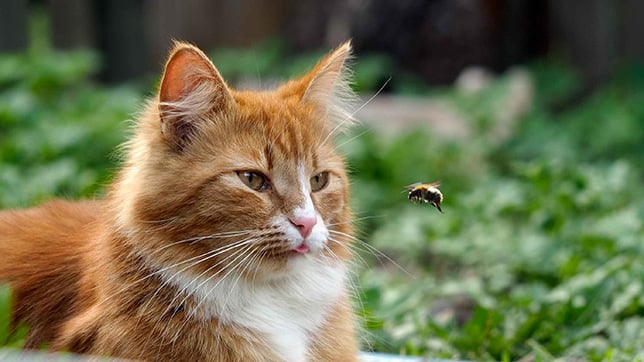
Summer is my favourite time of year. It’s also my cat’s favourite time of year: nicer weather means more time to spend outside chasing flies (and the occasional field mouse), sunbathing, flirting with the feline female next door (who can’t stand him) and generally terrorising the neighbourhood. But summer also comes with its own set of season-specific risks for our pets. The one I’d like to focus on today is wasp and bee stings in dogs and cats, with an emphasis on practical steps for prevention and first aid/handling of these when they occur. Let’s get buzz-y!
Practical Steps for Prevention of Wasp and Bee Stings in Dogs and Cats
- Avoid flowering plants. As beautiful as these are (and as much as I agree that it’s important we do everything we can to support bee populations), pets and flowering plants simply don’t mix well. These glorious, colourful blooms attract wasps and bees, so take a wide berth when walking your dog and avoid planting blossoming vegetation in your garden if you share it with a curious cat.
- Secure garbage bins. Ensure outdoor rubbish is tightly secured to avoid attracting wasps on the hunt for a snack.
- Clean up spills. Promptly address food and drink spills outside (and inside, should your windows be open) to avoid drawing in unwanted winged guests!
- Avoid sweet scents. Refrain from using pet shampoos or sprays with strong scents, especially fruity or floral fragrances. These can be irresistible to buzzing insects, who may investigate thinking they’ve found a flower or a fruity snack! Pungent smells (even those we find pleasant) can be offensive to our pets’ sensitive noses, in any case.
- Supervise outdoor time. Keep a closer eye on your pets during summer when they are outside so that you’re able to intervene more quickly in the event of a close call with a wasp or bee.
- Eliminate nests. Regularly check your home and outdoor spaces for wasp nests (these are grey-brown in colour, shaped similarly to a football and made of a soft, woody material). Make sure your pets aren’t able to go anywhere near any nests, or – if that’s impossible to control – consider professional pest control to facilitate safe removal of the nest.
- Pest Proofing Your Windows. Consider installing mesh screens to prevent entry of wasps and bees to your home through open windows.
First Aid/Action Steps: What to Do
Stings are painful, especially bee stings as the stinger may actually be left behind in your pet’s skin. You may witness a sting occurring, or you may guess that one is likely to have occurred due to your pet yelping, crying out, or suddenly becoming painful, after playing in the garden or during a walk.
Soreness, swelling, redness, drooling/salivation or sometimes hives are common signs of a wasp or bee sting. Wasp and bee stings can cause sudden-onset limping if they occur on a foot, or pain in the mouth or throat if swallowed by an overly inquisitive pet. Stings in the mouth and throat require extremely close attention as swelling of these areas have the potential to affect an animal’s breathing.
Stings tend to cause swelling, and again, if this affects the mouth or throat, immediate veterinary attention and then careful monitoring are required. Stings on limbs and those distant to the face don’t always require a vet visit; mild reactions can often be managed at home.
In the event of a known or suspected wasp or bee sting, follow these actions steps:
- Establish the location of the sting and the current severity of the signs. Those that are causing severe swelling of the face, or any swelling of the neck, mouth or throat require an immediate vet visit, as do the rare instances where signs of anaphylaxis such as rapid breathing or collapse occur.
For stings elsewhere, or those with milder signs, I recommend contacting us at The Net Vet so that we can assess your pet remotely.
- Check for a visible stinger in your pet’s skin. This will appear like a small black dot or splinter. If found, use a pair of tweezers to grasp the stinger as close to the entry into the skin as possible and carefully pull it out.
- Bathe the area in a basin of cool water to reduce pain and swelling. You can also use an ice pack, carefully wrapped in a towel. Use with caution and ensure you don’t make the area too cold.
- Monitor your pet for 24 hours and check their symptoms fully resolve. If symptoms are still present after this time, contact us again so that we can reassess.
By taking proactive measures to prevent stings you can significantly reduce the risk of these unwanted encounters. And of course, you now know how to provide immediate first aid and when to seek veterinary care. With these precautions in mind, I hope that you and your pets can enjoy a safer summer. Let’s raise a proverbial glass of prosecco (or an icy beer, Tango or Sprite out of the coolbox if that’s your thing), and enjoy this glorious season of outdoor memory making.